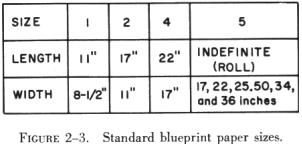Although title blocks do not follow a standard form, insofar as layout is concerned, all of them will present essentially the following information:

| Every print must have some means of identification. This is provided
by a title block (see figure 2-2). The title block consists of a drawing
number and certain other data concerning the drawing and the object it
represents. This information is grouped in a prominent place on the print,
usually in the lower right-hand corner. Sometimes the title block is in
the form of a strip extending almost the entire distance across the bottom
of the sheet.
Although title blocks do not follow a standard form, insofar as layout is concerned, all of them will present essentially the following information: |
 |
1. A drawing number to identify the print for filing purposes and to
prevent confusing it with any other print.
2. The name of the part or assembly.
3. The scale to which it is drawn.
4. The date.
5. The name of the firm.
6. The name of the draftsmen, the checker, and the person approving
the drawing.
Drawing or Print Numbers
All prints are identified by a number, which appears in a number block in the lower right-hand corner of the title block. It may also be shown in other places - such as near the top border line, in the upper right-hand corner, or on the reverse side of the print at both ends - so that the number will show when the print is folded or rolled. The purpose of the number is for quick identification of a print. If a print has more than one sheet and each sheet has the same number, this information is included in the number block, indicating the sheet number and the number of sheets in the series.
Reference and Dash Numbers
Reference numbers that appear in the title block refer a person to the numbers of other prints. When more than one detail is shown on a drawing, dash numbers are used. Both parts would have the same drawing number plus an individual number, such as 40267-1 and 40267-2.
In addition to appearing in the title block, dash numbers may appear on the face of the drawing near the parts they identify. Dash numbers are also used to identify right-hand and left-hand parts.
In aircraft, many parts on the left side are like the corresponding parts on the right side but in reverse. The left-hand part is always shown in the drawing. The right-hand part is called for in the title block. Above the title block will be found a notation such as: 470204-1LH shown; 470204-2RH opposite. Both parts carry the same number, but the part called for is distinguished by a dash number. Some prints have odd numbers for left-hand parts and even numbers for right-hand parts.
Universal Numbering System
| The universal numbering system provides a means of identifying standard drawing sizes. In the universal numbering system, each drawing number consists of six or seven digits. The first digit is always 1, 2, 4, or 5 (figure 2-3), and indicates the size of the drawing. The remaining digits identify the drawing. Many firms have modified this basic system to conform to their particular needs. Letters may be used instead of numbers. The letter or number depicting the standard drawing size may be prefixed to the number, |
 |